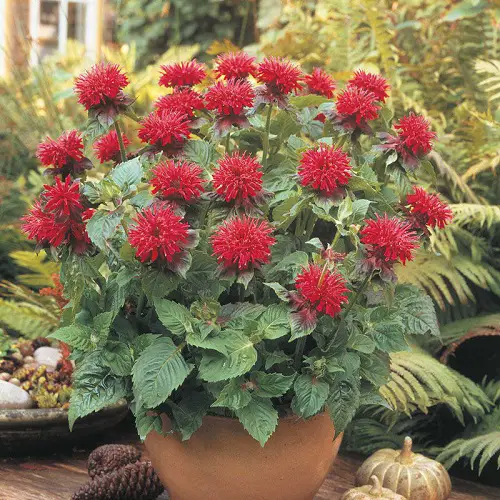Read on to learn everything about Bee Balm Benefits and the other health advantages this plant has on offer!

Native to North America, this plant is popular for its bright, fragrant flowers that attract various pollinators, making it an excellent addition to any garden. In addition to this, there are many Bee Balm Benefits that will surely tempt you into growing it.
Check out Bee Balm Companion Plants
Bee Balm Plant Profile
Bee Balm, also popular as Monarda, is a herbaceous perennial plant native to North America. It grows up to 2-4 feet in height and has lance-like, aromatic leaves with sturdy, erect stems.
The flowers of Bee Balm are showy and fragrant and come in colors such as pink, red, purple, and white. They have dense, spherical clusters that bloom in mid to late summer, attracting pollinators such as bees, butterflies, and hummingbirds.
Is Been Balm Edible?
Yes, Bee balm is edible. Its leaves have a lemony, minty flavor and can be used fresh or dried to make tea or as a seasoning in recipes. The flowers are also edible and can be used as a decorative addition to salads or desserts.
However, it is important to note that some individuals may experience allergic reactions to bee balm, so it is best to try a small amount first before consuming it in larger quantities.
Look at some Stunning Flowers Starting with ‘B’
Bee Balm Benefits

1. Attracts Pollinators
It is highly attractive to pollinators such as bees, butterflies, and hummingbirds, offering them sweet nectar. By planting bee balm, you can help support pollinator populations and create a vibrant and thriving garden environment.
2. Has a Long Blooming Period
Gardeners love Bee balm for its long blooming period, which lasts from mid-summer to fall, providing a burst of color and interest in the garden for several months.
The brightly colored flowers of bee balm come in shades of pink, red, and purple that add visual interest to the garden throughout the winter months.
3. Can Be Used to Make Tea
Another Bee Balm Benefit is you can use it to add a refreshing citrusy flavor to the tea. You can add them to both cold and ice teas.
4. Tastes Great in Salad
The leaves and flowers of Bee Balm add refreshing flavor and color to salads. You can also use them to garnish.
5. A Super Seasoning Option
Use dry leaves of Bee Balm as a seasoning in a variety of dishes, including soups, stews, and sauces. It adds a unique citrusy flavor that pairs well with meats and vegetables too!
6. Can be Added Desserts
Bee Balm flowers are great for decorating desserts such as cakes, cupcakes, and fruit salads. They add a pop of color and a pleasant citrusy flavor.
7. Used in Jelly and Syrup
The flowers of Bee Balm are popular for making a fragrant and flavorful jelly or syrup that can be used to top pancakes, waffles, or ice cream.
8. Provides Natural Pest Control
Bee balm plants are highly attractive to bees, butterflies, and other pollinators. These beneficial insects help to control unwanted pests that can damage other plants in your garden.
Health Benefits of Bee Balm
1. It has Anti-inflammatory and Antimicrobial Properties
Bee Balm contains compounds such as thymol and carvacrol, which have anti-inflammatory properties. These compounds can help reduce inflammation and swelling in the body.
A study reveals that bee balm essential oil and its constituents exhibit a broad spectrum and variable degree of antibacterial activity against different strains. Among the tested strains, Streptococcus pyogenes, Escherichia coli, and Streptococcus pneumoniae were the most susceptible bacterial strains, showing the lowest MIC and MBC values.
2. Aids in Digestion
Bee Balm has a calming effect on the digestive system, making it useful in treating digestive disorders such as indigestion and bloating.
It can also help soothe the lining of the stomach and reduce inflammation, making it useful in treating conditions such as gastritis and ulcers.
Check out Low Maintenance Houseplants With Health Benefits
Requirements to Grow Been Balm

- Sunlight: This plant needs direct sunlight for at least six hours daily.
- Soil: Been Balm plants prefer well-drained, nutrient-rich soil with a pH of 6.0 to 6.5.
- Water: Water the plant regularly, but not too much. The soil should be kept moist but not soggy.
- Pruning: It needs to be pruned frequently to promote healthy growth and keep them from becoming too tall and lanky.
- Fertilizer: Been Balm plants should be fertilized once a month with a balanced fertilizer.



